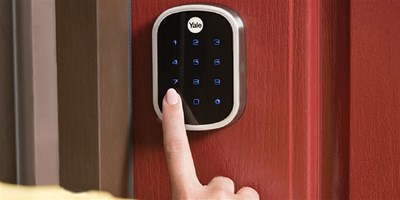The next couple weeks find us winding down one busy year and entering a new one. Many of us use this time to reflect on the previous year and make changes for the new year. Hitting new fitness goals, spending more time on self-improvement, and spending money more wisely make up common New Year’s Resolutions. Additionally, we at Northeast Security Solutions urge you to focus on improving your home security this year as well. In this post, we share some of our top security resolutions for the new year. We’ll share some basic tips for updating your way of thinking about security. These will include tips for planning ahead and involving neighbors in your security plan. Furthermore, we’ll share some ideas for upgrading old equipment and taking advantage of the latest security technology. Let’s start with some ideas for leaving bad security habits in the past during the upcoming year.

While leaving windows open allows homes to air out, doing so while leaving the house provides an open invitation to burglars.
Eliminate Lazy and Ineffective Security Habits
In our post on Avoiding Common Security Mistakes, we pointed out the risk of certain outdated “security” practices. In that post, we specifically addressed the issue of leaving spare keys in easy-to-find places. Of course, homeowners take other such risks with their security as well. For example, many homeowners fail to lock their deadbolts when they take a “quick trip” to a nearby location. Breaking in through a deadbolt generally requires picking alock or using tools to defeat the lock. However, breaking in through a latch bolt on a doorknob often requires only a credit card. Failing to lock deadbolts for any amount of time greatly decreases your security.
Similarly, many people fall victim to a break-in because they leave windows open. Failing to close and lock windows — whether intentionally or accidentally — also invites criminals. Many homeowners have the feeling that if burglars really want to get in, they’ll get in anyway. Therefore, why bother going through the trouble of making their home as secure as possible when leaving? In reality, thieves give themselves a very short window to break in to a home and commit their crime. Too much resistance getting in often results in an abandoned break-in attempt. If you take steps to eliminate lazy security habits as one of your security resolutions, you can turn your home from low-hanging fruit to a more difficult target for burglars.
Get to Know Your Neighbors
In our post on improving Safety and Security Over the Holiday Season, we introduced the concept of asking neighbors for help with home security. Involving your neighbors in your security plan reaps many benefits. For one, they can help make your house a less obvious target when you travel. Having neighbors gather any mail and occasionally park in your driveway makes the house look occupied. Additionally, asking neighbors to do these favors can lead to their further involvement in watching over your home. If a neighbor catches suspicious activity around your home while you are gone, they will be much more likely to let you know about it if you’ve asked for their assistance before. The more friendly eyes you have watching over your house, the better. Therefore, we suggest adding this step to any list of security resolutions for the new year.
Update Antiquated Security Equipment
As we pointed out in our post on Security System Upgrades, many homeowners have helplessly outdated security equipment. This can hurt homeowners’ security in many ways. Older security panels, for example, may not send test signals to test for communication between your alarm and the central station. Modern panels send periodic messages to the central station to ensure this connection stays active. If you have a security panel that does not send this periodic test signal, we strongly recommend upgrading your panel. All too often, alarm owners don’t discover their system’s communication issues until a break-in. Of course, at this point an upgrade does nothing to reverse the damage already done. Call your security provider if you are unsure whether or not your own security system self-tests for communication.
Additionally, some security devices require an upgrade after a set amount of time. Many homeowners add monitored fire detection to their home security systems. In some cases, this monitored fire detection is the only smoke and carbon detection in the home. Smoke and carbon monoxide detectors, in particular, often remain installed past their listed lifespan. Homeowners should change out smoke and heat detectors every ten years. Carbon monoxide detectors have an even shorter lifespan, at 5 years. If your security system includes any fire detection equipment, keeping it up to date should rank amongst your highest security resolutions this year.
Take Advantage of Modern Security Technology
It’s never been easier to create a modernized home security plan than it is right now. We still receive plenty of phone calls asking for basic security equipment. However, now more than ever homeowners want security with all the bells and whistles. For example, adding interactive cellular monitoring allows users to control their alarm remotely. Our cell dialer, powered by Alarm.com, allows users to do just that. Completing this step also allows you to take other security measures. Let’s look at a couple technology-aided security measures that not all security customers know about.

Smart locks, such as this model by Yale, makes leaving spare keys outside a thing of the past.
Adding smart home features to a home alarm system has been one of the biggest recent trends in the industry. Some of these devices add home security. Smart locks, for example, allow you to lock and unlock your door with codes instead of keys. This avoids the dreaded “loose spare key” situation described earlier. Now you can let guests in with unique user codes that you can add and delete at any time. Furthermore, you will have the ability to lock and unlock your smart lock remotely. This allows you to let people in for one-time entry with no key or code required.
Other smart home products save both energy and money. Smart thermostats provide a prime example. These thermostats allow you to control the temperature of your home remotely. Keeping the house relatively cool while unoccupied, then raising the heat to comfortable levels before people start arriving again, keeps heating bills down without taking away comfort. Additionally, you’ll receive an alert if your home temperature leaves your desired range. This can alert you to a frozen pipe or other emergency situation. Knowing this in advance instead of stumbling upon the situation after arriving home can save a major headache. If adding smart home technology is one of your security resolutions, check out our post on Security System Add-Ons for Your Smart Home.
Make Your Mobile Phone Your Security Center
Awhile back, we posted some tips to help you Use Your Smart Phone to Add Security to Your Alarm. Homeowners count on their smart phones to complete a huge variety of tasks. Just about any industry that wants to stay relevant has had to adjust to this fact. Of course, the alarm industry is no exception. We’ve already mentioned the ability to remotely arm and disarm your security system. Adding interactive cellular monitoring also allows you to receive customizable text alerts for alarm events or status updates. You can set up alerts for any event ranging from a potential break-in to a low sensor battery. Additionally, setting up equipment and smart phone notifications to monitor activity around your home adds a whole new level of security.
For example, consider installing contact sensors in important areas of your home. These sensors can help you monitor spots like liquor cabinets, jewelry cases, or pool doors. If anyone opens a door alarmed with a contact sensor, you will receive a smart phone notification even when your alarm system is disarmed. Our post on Unconventional Uses for Contact Sensors can help you decide where to place these sensors. Your phone can also act as a panic button which activates your alarm on demand. If you have regular access to a smartphone, you should strongly consider adding extra security through this device to your list of security resolutions.

Severe weather can harm electronic equipment if you do not prepare for it. Making emergency preparation one of this year’s security resolutions can help alleviate this danger.
Create a Plan to Deal with Any Situation
From weather emergencies, to fires, to vacations, we encourage planning in advance from a security perspective for any situation. Think of the upcoming year and the types of security challenges that you can already predict. When it comes to security, planning ahead goes a long way. Furthermore, we’ve likely created a post in the past year that can help with these challenges. A family with young children, for example, could benefit from finding ways to Improve Fire Safety for Your Family. Families who travel often may want to read our Vacation Security System to-Do List. Unfortunately, security issues often fall by the wayside if we fail to plan ahead. Use this time of year to do so.
Additionally, take time to plan for unforeseen events. In addition to taking safety measures for events on your calendar, think of what you might encounter over the next year. Power outages, storms, and other surprises can all impact on your security equipment. They can also negatively impact your peace of mind. Take steps to address these now so you don’t feel surprised when they happen. Our Emergency Preparation Tips for Alarm Customers can help you with this process. Any list of security resolutions should include plans to deal with both expected and unexpected changes.
Resolve to Keep an Eye on Your House at all Times
More and more homeowners install residential security cameras as a part of their home security plan. We always recommend taking this step as a way to accomplish two security goals. For starters, cameras allow you to look in on your home remotely at any time for any purpose. Some homeowners have security concerns and want to ensure that cameras record any potential crime occurring on their property. Others want to make sure kids arrive home from school on time, or that pets stay off their furniture. Regardless of the reason for installing them, cameras can do it all.
In addition, cameras act as a deterrent for potential burglars, encouraging them to find another target. The mere sight of these devices can drive away most criminals. Due to this fact, many homeowners install fake, or “dummy,” security cameras to receive this security benefit. However, as we point out in our post on Fake Security Cameras, these cameras fool very few shrewd thieves. Instead, consider installing operational cameras at the locations most likely to attract attention from burglars. This will greatly increase your home security. The ability to catch a crime in progress or deter a crime before it happens should place adding home surveillance on your list of security resolutions.
Creating Security Resolutions for a Safe New Year
We hope that this post has given you some ideas for improving your home security in the new year. Security resolutions may not receive as much attention as those related to health and fitness. However, we should always look for ways to increase home security. If you have any questions about the material in this post, do not hesitate to contact us. We offer free home site surveys to address any security concerns you may have. Additionally, we will also make suggestions of our own during our visit. Together, we can create a plan to help you increase your home security both now and in the years to come.
